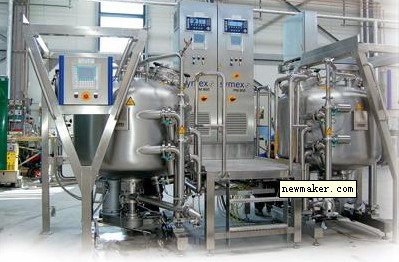Unifying the contradictory requirements of the production process, this is the current trend in the production of tablets, capsule outer coatings and outer film. A solution that meets these needs has been born, which enables continuous pharmaceutical production as well as intermittent batch production. Not only in the production process of sugar coatings and film, when the medicine is emptied from the batch production container and the medicine is delivered to the production line, the flow rate and the input energy in the batch production container are kept constant. When the volume of the drug in the batch production container is decreased, it is necessary to ensure that the input shear energy does not cause the ejection action, and the drug does not adhere to the surface of the container due to drying.
The production of pharmaceutical products is constantly demanding more flexibility and higher technical content for pharmaceutical production process technology and production system process methods. The high demands of product production determine the complexity and flexibility of the entire pharmaceutical production system, such as the outer coating of tablets and capsules and the production process of the film.
In most cases, based on the deposition of the particles and the inhomogeneity, it is impossible to form an intermediate layer or an outer layer of sugar coating and film conversion. The consequence is that in the production process, the batch production container must always have an equal amount of uniform particle suspension (generally, only the uninterrupted use of the homogenizer can achieve this effect). The homogenizer is capable of producing reverse flow and eddy currents in the batch production vessel that prevent particle deposition. At the same time, the amount of flow caused by shear stress is also provided directly by the shear gap, not proportional to the input mechanical energy. The input energy must be accurately regulated according to the flow conditions, because excessive shear forces from the shear gap will result in an uncontrolled concentration increase until the drug is fully cured. 
The above situation puts new demands on the production process of drugs. In the past few years, although pharmaceutical products manufacturers have put a large number of mixing equipment and mixing systems into the market, there is no comprehensive solution that can meet the requirements of this special process technology. A set of sugar coating equipment developed by Symex has opened up a new way to solve this technical problem. This is a two-station equipment with two identical, parallel-arranged mixing vessels to ensure continuous operation of the line. When a mixing vessel is mixed and continuously emptied and sent to the production line, the other mixing vessel is subjected to CIP in-situ cleaning to add the next batch of raw materials. The driving and working of these two systems are independent of each other. But their operation and control is the responsibility of an operator.
The unit power of the system and the structural design of the system ensure that short process production times and hygienic cleaning times can be achieved. The loading station directly above the mixing vessel transports the previously weighed raw materials neatly and continuously into the mixing vessel. Each mixing vessel operates in accordance with the principle of a rotor-stator homogenizer. They are capable of uniformly generating particulate suspension at high flow rates with low energy consumption. The rotor-stator conversion pump agitating homogenizer is installed at the bottom of the mixing vessel, and its working condition is periodically matched as the amount of the drug in the container is gradually reduced. There are two inlets for the mixer periodic circulation system, which ensure that the product capacity in the container can enter from the tangential inlet when the container is full and half container. When the capacity in the batch container is less than 30% of the minimum fill, the product will enter the mixing vessel through a dedicated inlet. In this way, even in the case of a minimum capacity, it is ensured that a cyclone is prevented from forming in the container, and flow monitoring is reliably ensured.